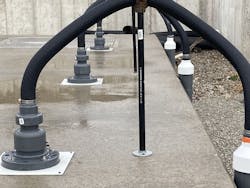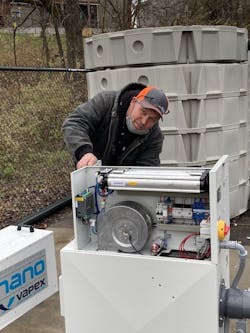About the author:
Jim Force is a writer with work encompassing aspects of the water and wastewater industry. Force can be reached at [email protected] or 715.845.9571.
Located in the Kansas City metro area south of Independence, Lee’s Summit Water Utilities has provided the city with water, sanitary sewer, and fire protection services for more than 100 years, ensuring the health, safety and future growth of a community of about 90,000.
What began as a water system of less than 5 miles of infrastructure in 1916 now boasts 603 miles of water mains and 480 miles of sanitary sewer lines to serve more than 37,700 customer accounts throughout the service area. Powered by 22 lift stations, the sewer system conveys wastewater to the Little Blue Valley Sewer District in Independence for treatment.
For years, the Lee’s Summit Water Utilities operated and maintained a mixed bag of different technologies to control odors at its lift stations. The city used everything from chemical scrubbers to activated carbon adsorbers to ion exchange units, with the result that operation and maintenance was different at each location, and the collections team had to stock a wide variety of parts.
“These lift stations were put in before the water utility had its own engineering staff,” said Mike Riley, operations and maintenance manager for Lee’s Summit Water Utilities. “Contractors specified the odor control equipment, and it was all different. It didn’t make sense.”
However, now the utility is standardizing on hydroxyl radical misting technology developed by Vapex Environmental. The change-over has allowed the utility to become familiar with the technology, and develop an expertise in installing, operating and servicing the units.
This technology has improved on the previous control methods to the point that any odors and any associated complaints have practically disappeared.
Odor Control Unit Installation
A few years ago, Lee’s Summit began looking for a better and more effective odor control method to apply to a small wet well at its Lake Breeze lift station in an exclusive neighborhood featuring several million-dollar homes. The lift station is within 100 feet of some of these residences.
Riley recalls visiting Jefferson City, Missouri, on a trip to St. Louis and reviewing a Vapex unit the city had installed several years earlier.
“I decided to swing by and take a look at their unit in action,” Riley said. “It was inside a wet well and I thought that the technology might work for us.”
In Vapex units, the hydroxyl radical mist is made up of air, less than 5-µ sized water particles and ozone. It is directed into an odorous area through a patented three-fluid nozzle and attacks hydrogen sulfide, stripping out hydrogens and leaving only water and a sulfur molecule.
As a result, a new single nozzle Vapex PICO model was installed at the lift station in Lee’s Summit to address the utility’s odor control woes. The wet well is 8 feet in diameter, 19.5 feet deep, with 750 cubic feet of open area at the lowest water level. The unit occupies a small footprint and uses just 1.5 gallons of water per hour. The electrical power draw is about the same as a standard household refrigerator.
Riley said the old scrubbing unit would treat the foul-smelling air and then release it into the atmosphere, resulting in potential complaints if the unit malfunctioned. But the Vapex unit does not pull treated air out of the unit and exhaust it. Rather, it treats the air in place, destroying odors inside the lift station itself.
“Our technical staff was able to install the unit,” Riley said. “It requires only electrical power and a source of water — both available at the lift station site.”
As part of the contract, he added, Vapex personnel as well as the local representative were on hand to supervise startup and review maintenance procedures. Riley said that because of cold weather in winter, the water supply lines have been encased in heat taping.
“It’s running beautifully,” he said. “It does what we thought it was going to do.”
Expanding to Scrugg’s Road Lift Station
Based on this success, Lee’s Summit ordered a second unit a year later for its Scrugg’s Road lift station. It is the second largest lift station in its system, with a wet well dimension of 26 by 18 by 30 feet, and treats a volume of 11,230 cubic feet at the lowest water level.
The unit is a four-nozzle Micro model, the second largest model the company offers. It also provides two-way communication for real-time monitoring and programmable oxidant levels to treat diurnal flows.
The lift station is located at a dip in a road and Riley said that during hot humid summer months, odors would hang in the valley without the technology and this would bother drivers passing the station.
“There were strong odors, and drivers would catch that as they drove by,” Riley said. “The old unit using activated carbon pellets was never 100% at eliminating odors.”
There have been no odor complaints since installation in January 2020, again because the unit does not emit treated air but keeps it inside the well.
Riley says the unit has also made an impact on fats, oils, and grease in the lift station.
“Vapex units can destroy FOG, too, and even though our unit is not as close to the water as recommended for FOG control, we have seen a big reduction in FOG buildup in the lift station,” he said. “Where it used to be up to a foot thick, it’s now just an inch or two. We’re saving money on grease removal and disposal.”
Lee’s Summit plans to take delivery of a third unit in the near future, to be applied at another lift station.


